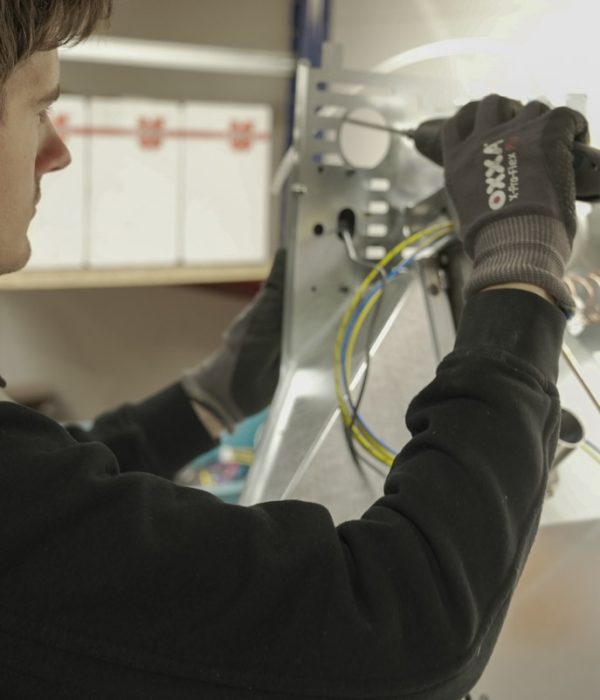Installation of a pellet stove
Installation
Installation of a pellet stove
When you buy a pellet stove, you are not just buying the stove itself; you are choosing to install a heating appliance in your home. A pellet stove cannot function properly without expert installation.
But what should you actually pay attention to when buying and installing a pellet stove?
On this page, you will find all about:
- What is important for a sound installation
- Exactly what a pellet stove installation will cost
- Exactly what to expect at your installation

1. Safe installation
If you opt for a pellet stove, make sure you have it installed by a recognised installer. Do you want to be sure that the pellet stove is installed entirely according to Duroflame regulations?
Then choose the Duroflame installation service. You can calculate the costs directly online.
2. A good flue prevents inconvenience
A pellet stove generates flue gases. However clean the combustion in our optimised combustion chambers, these gases should absolutely not enter your living room. A flue offers the flue gases a way out.
Flue pipes must be installed according to the rules in the building regulations. The flue must discharge above the ridge of the roof to prevent nuisance for local residents.
3. Choose a good, convenient spot
So, that’s an open door! But what is a convenient place for a pellet stove? After all, you want to be able to feel the cosy warmth, but also enjoy the flames at the same time. What you like is of course completely personal, but there are still a few rules of thumb that can get you started:
- Keep well away from combustible materials such as furniture and carpets. The distance from combustible materials is different for each stove, you will find this information in the user manual and installation instructions.
- Keep the pellets themselves well away from the pellet stove, at least 150 cm away. After all, they are highly flammable.
- Always keep some distance from the wall. How much distance you should keep depends on the type of stove you install.
- Depending on your living situation and the selected output, the pellet stove will heat very comfortably up to a few metres away. So you can comfortably place the stove 2 or 3 metres away from an armchair or sofa and still enjoy the comfort of a pellet stove.
- You need a stable, fire-resistant surface. So an unstable wooden floor or nice high-pile carpet do not lend themselves to the installation of a pellet stove. By the way, steel and glass base plates are available that can shield the surface.
4. Power on the stove
Electricity? But my pellet stove uses wood pellets, right?
Absolutely right! All pellet stoves do require a (small amount of) electricity. So our pellet stoves are equipped with a control unit, smart electronics that continuously monitor and adjust the combustion process for optimum efficiency. The flue fan, which ensures that there is draft in the flue, also runs on electricity, of course. This keeps combustion efficient and clean.
But even when your stove is not on, the electronics work. For instance, you can make use of the weekly schedule, which starts the stove at preset times.
What does the installation of a pellet stove cost?
As the only Dutch manufacturer of pellet stoves, we regularly get the question, ‘What does the installation of a pellet stove cost?’.
A very logical question, after all, a pellet stove is not a plug-and-play product. It is a sophisticated appliance that needs an air supply and a professionally laid flue to function properly and safely. An installation must comply with various regulations, including NEN 2757-01: 2019 / NPR 2758.
Bespoke
An installation is truly custom-made; sometimes the pipe has to be placed just around an obstacle. In another house, a flue needs to be raised just a little. To give you an idea of the work and costs, we have nevertheless worked out three common situations. In all cases, we recommend you ask for a free, no-obligation customised quote.
Introduction pellet stove components
Every pellet stove consists of several parts. We have listed the most important parts, with explanations.
The firing schedule of Duroflame pellet stoves consists of 6 stages:
Fire pot
A ‘combustion chamber’ where the pellets are ignited and burn at a controlled rate. This is where all the heat of the pellet stove is created.
Ash tray
This is where all ashes are collected. Advice is to clean regularly before use.
Exhaust fan
Pushes the gases created by the burnt pellets out of the combustion chamber.
Circuit board
The circuit board or also called motherboard controls all the components in the heater.
Control panel
The control panel or display is used to operate the stove.
Data cable
The data cable or flatcable connects the board and the control panel.
Auger motor
The auger motor is attached at the bottom of the auger or so-called worm. This is an electric motor with a transmission to 4 or 2 revolutions.
Mortar
This is a shaft with a spindle around it. This rotates at low speed by means of the auger motor and raises the pellets
Pressure monitor
The pressure switch measures the back pressure in the outlet. If the back pressure is high, the switch will toggle and the stove will give a fault. The auger motor will then not receive power.
Maximum thermostat
The maximum thermostat monitors the maximum temperature of the pellet tank. As soon as it gets too high, the thermostat will switch over and the stove will give a malfunction. The auger motor will then not receive power. You can reset the maximum thermostat by pressing the reset button. This can be found at the back of the stove. Here you will see a black cap with a diameter of about 1cm that you can unscrew. You can press this to reset the maximum thermostat.
Glow plug
The glow plug is an element that glows during ignition. It is located in the tube you can see at the bottom of the burner pot
Flue gas fan
The flue fan extracts the flue gases inside the stove and creates a negative pressure inside the stove and blows flue gases into the flue outlet. In this way, oxygen is also sucked through the burner pot. The flue fan rotates at different speeds to achieve proper combustion.
Convection fan
The convection fan blows air from the room through the heat exchanger to cool the pellet stove.
Encoder
This is a sensor that measures the speed of the flue fan. This is usually a black cap on top of the flue gas fan where a wheel turns. In a pellet stove with a continuously running auger motor, this encoder is also on the auger motor.
Flue gas temperature sensor
This is a sensor that measures the temperature of the flue gases. In this way, it can determine how much fire is present in the stove.
Room temperature sensor
This is a sensor that measures how warm it is in the room. Based on this, the stove can determine whether it should modulate. Make sure this sensor is placed in a representative place. So do not place it directly on the floor or against a wall. In that case, it will not measure the ambient temperature but the floor or wall.
Wondering how and where to install a pellet stove?

